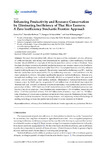Enhancing Productivity and Resource Conservation by Eliminating Inefficiency of Thai Rice Farmers: A Zero Inefficiency Stochastic Frontier Approach
| dc.contributor.author | Liu, J | |
| dc.contributor.author | Rahman, Sanzidur | |
| dc.contributor.author | Sriboonchitta, S | |
| dc.contributor.author | Wiboonpongse, A | |
| dc.date.accessioned | 2017-05-15T10:37:03Z | |
| dc.date.accessioned | 2017-05-15T13:53:56Z | |
| dc.date.available | 2017-05-15T10:37:03Z | |
| dc.date.available | 2017-05-15T13:53:56Z | |
| dc.date.issued | 2017-05-08 | |
| dc.identifier.issn | 2071-1050 | |
| dc.identifier.issn | 2071-1050 | |
| dc.identifier.other | 770 | |
| dc.identifier.uri | http://hdl.handle.net/10026.1/9253 | |
| dc.description.abstract |
The study first identified fully efficient farmers and then estimated technical efficiency of inefficient farmers, identifying their determinants by applying a Zero Inefficiency Stochastic Frontier Model (ZISFM) on a sample of 300 rice farmers from central-northern Thailand. Next, the study developed scenarios of potential production increase and resource conservation if technical inefficiency was eliminated. Results revealed that 13% of the sampled farmers were fully efficient, thereby justifying the use of our approach. The estimated mean technical efficiency was 91%, implying that rice production can be increased by 9%, by reallocating resources. Land and labor were the major productivity drivers. Education significantly improved technical efficiency. Farmers who transplanted seedlings were relatively technically efficient as compared to those who practised manual and/or mechanical direct seeding methods. Elimination of technical inefficiency could increase output by 8.64% per ha, or generate 5.7–6.4 million tons of additional rice output for Thailand each year. Similarly, elimination of technical inefficiency would potentially conserve 19.44% person-days of labor, 11.95% land area, 11.46% material inputs and 8.67% mechanical power services for every ton of rice produced. This translates into conservation of 2.9–3.0 million person-days of labor, 3.7–4.5 thousand km2 of land, 10.0–14.5 billion baht of material input and 7.6–12.8 billion baht of mechanical power costs to produce current level of rice output in Thailand each year. Policy implications include investment into educating farmers, and improving technical knowledge of seeding technology, to boost rice production and conserve scarce resources in Thailand. | |
| dc.format.extent | 770-770 | |
| dc.language | en | |
| dc.language.iso | en | |
| dc.publisher | mdpi | |
| dc.relation.replaces | http://hdl.handle.net/10026.1/9248 | |
| dc.relation.replaces | 10026.1/9248 | |
| dc.subject | technical efficiency | |
| dc.subject | Zero Inefficiency Stochastic Frontier approach | |
| dc.subject | rice production | |
| dc.subject | Thailand | |
| dc.title | Enhancing Productivity and Resource Conservation by Eliminating Inefficiency of Thai Rice Farmers: A Zero Inefficiency Stochastic Frontier Approach | |
| dc.type | journal-article | |
| dc.type | Journal Article | |
| plymouth.author-url | https://www.webofscience.com/api/gateway?GWVersion=2&SrcApp=PARTNER_APP&SrcAuth=LinksAMR&KeyUT=WOS:000404127800095&DestLinkType=FullRecord&DestApp=ALL_WOS&UsrCustomerID=11bb513d99f797142bcfeffcc58ea008 | |
| plymouth.issue | 5 | |
| plymouth.volume | 9 | |
| plymouth.publisher-url | http://www.mdpi.com/journal/sustainability | |
| plymouth.publication-status | Published | |
| plymouth.journal | Sustainabilty | |
| dc.identifier.doi | 10.3390/su9050770 | |
| plymouth.organisational-group | /Plymouth | |
| plymouth.organisational-group | /Plymouth/Faculty of Arts, Humanities and Business | |
| plymouth.organisational-group | /Plymouth/Users by role | |
| dcterms.dateAccepted | 2017-04-29 | |
| dc.identifier.eissn | 2071-1050 | |
| dc.rights.embargoperiod | No embargo | |
| rioxxterms.versionofrecord | 10.3390/su9050770 | |
| rioxxterms.licenseref.uri | http://www.rioxx.net/licenses/all-rights-reserved | |
| rioxxterms.licenseref.startdate | 2017-05-08 | |
| rioxxterms.type | Journal Article/Review | |
| plymouth.oa-location | http://www.mdpi.com/2071-1050/9/5/770 |


